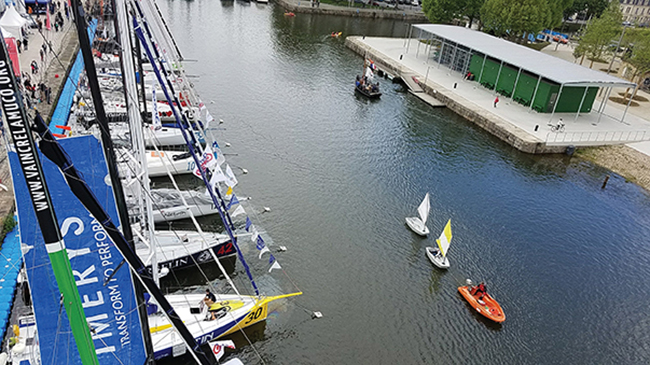Competing in the Normandy Channel Race 2017, was a huge opportunity and a huge challenge for two eager amateurs (published August 2017)
The Normandy Channel Race is a 1,000-mile, double handed Class 40 race starting and finishing in Caen, France. It was the first big Class 40 race on the 2017 calendar and attracted the biggest names in the class. The race takes the fleet on a zig zagging course across the English Channel, around the Isle of Wight, and along the south coast of England to Land’s End, where the course then turns right and heads across the Eastern Irish Sea to round Tuskar Rock, on the south-eastern corner of Ireland, then along the south coast of Ireland to the iconic Fastnet Rock and back to France, leaving the island of Guernsey to port along the way.
Caen is a bustling city in Normandy. The city has gone through a renaissance of sorts over the past 20 years and has shed the shabby post war, cement buildings and is now the picture of a modern French city with cobblestone streets, open air cafes and restaurants where patrons eat delicious food and sip good wine. The fleet of 25 Class 40 race boats were moored stern to the quay right in the heart of the city. The race organizers set up a full race village where families and onlookers could check out the boats and skippers.
In France, offshore sailing is serious sport and the French crowds strolled the quay hoping to spot the next great offshore superstar. It was the first time in my sailing career I had been asked for an autograph. Stefane Bry, the owner of Sirius and my co-skipper, and I were not the next sailing superstars. We fell into the ranks of the low funded but enthusiastic amateurs. We both have full time day jobs. Stef is a journalist from the island of St. Pierre, a small French protectorate in the North Atlantic, just to the south of Newfoundland. I am a design engineer at New England Boatworks in Portsmouth, RI, and live in Newport, RI. Shorthanded racing is a passionate hobby for both of us. We were outsiders in the crowd, I as the only American in the race and Stef was from the other side of the Atlantic, too. We were here for the adventure.
The fleet of 25 showcased the latest in Class 40 technology and thinking. The Class 40 is like a little brother to the IMOCA 60 and many of the best French offshore sailors use the class as a stepping stone to bigger things. The class is a box rule, like the IMOCA “Open” 60’s, where the design has to meet basic parameters but is open to development within that box.
In an attempt to reduce costs, the class restricts the use of materials so the hull and deck are made of fiberglass and carbon can only be used in the masts, booms and bow sprits. They also restrict the use of exotic materials such as titanium. Even with these restrictions, a new generation boat can cost upwards of $750,000 to build and run. The latest generation boats really are like scaled down IMOCA 60’s; purebred, shorthanded racing machines. The fine yacht Sirius is not of the latest generation. She is from the first generation of Class 40, designed and built when the boats were intended to cross the bridge between ocean racer and family weekender.
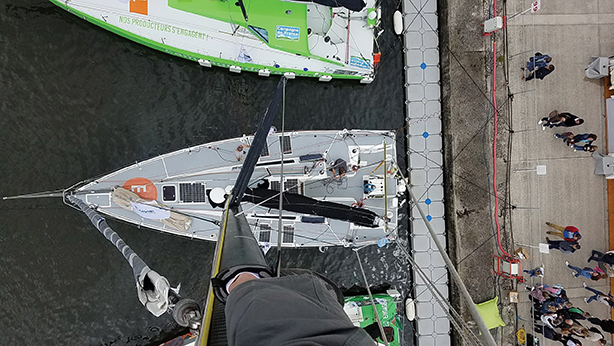 We were nestled between two of the newest boats and most competitive teams, V&B and Campagne de France. Next to these racing machines, Sirius looked a bit like we had brought the family sedan to a World Rally championship. The fleet is comprised of fully funded professionals at the top third of the fleet sailing the latest generations of boats with any one of eight teams capable of winning the race.
We were nestled between two of the newest boats and most competitive teams, V&B and Campagne de France. Next to these racing machines, Sirius looked a bit like we had brought the family sedan to a World Rally championship. The fleet is comprised of fully funded professionals at the top third of the fleet sailing the latest generations of boats with any one of eight teams capable of winning the race.
The favorites were Imerys, skippered by Englishman Phil Sharp and Spaniard Pablo Santurde, followed by V&B, skippered by Maxime Sorel, a 27-year-old up-and-coming offshore sailing superstar and co-skipper Antoine Carpentier, as well as Campagne de France skippered by Halvard Mabire, the president of Class 40 Association and partner Miranda Merron. Both of them are grizzled veterans of the Whitbread round the world race (now the Volvo race) with many thousands of racing sea miles between them.
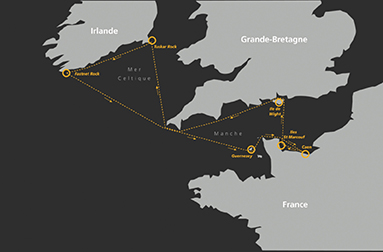 THE START
THE START
On start day, each team docked out to cheers from the crowd of spectators. As a fleet, we motored the eight miles down Canal de Caen à la Mer to the locks at Ouistreham. Local spectators picnicked on the green banks watching us go by, some cheering and waving flags in support. The race starts less than a mile off Gold Beach where, 76 years ago, the British-led forces came ashore to start the push toward Berlin.
It was warm and clear and the light northeasterly breeze was just filling in as the start gun went off. The fleet did the requisite ping pong legs around marks off Ouistreham for the benefit of the spectator boats before heading west across the Baie de Seine to our first turning mark, the Iles Saint-Marcouf. As one of the amateur boats, we took it easy for the start and first legs trying not to make any big mistakes.
By the time we left Ouistreham we were in the back third of the fleet, the rest were stretching away from us. Even in this light air, the speed difference between the new boats and the old boats was striking. As the afternoon turned to evening, with the historic Normandy beaches and green bluffs to leeward, the majority of the fleet was spread out in front of us. We were still in touch and fighting to eek all the speed out of Sirius we could. The light wind shifted aft and one by one, we transitioned from our reaching Code 0 to the big running kites. The sun set gorgeously off our bow as we ate the first of our freeze-dried dinners and we agreed that this was not a bad way to start our adventure.
We rounded the cardinal buoy at Iles Saint-Marcouf at 11pm and followed the fleet out into the English Channel, mast head lights all around us. The breeze built steadily through the night as the clouds rolled in from the southwest giving us fast sailing conditions as we picked our way across the channel, dodging shipping traffic.
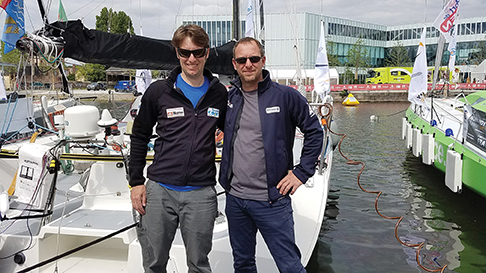 THE ENGLISH COAST
THE ENGLISH COAST
The dawn came overcast, misty and foggy. We ripped into the mouth of the Solent under full main and spinnaker in 15-to-17 knots of wind from the south-southeast. We could pick out a few of our competitors around us in the fog. We jibed to the northwest toward No Man’s Land Fort at 7am. Boat #127, our closest rival, jibed just before us and messed it up badly. As we blew passed them, both skippers were standing on the fore deck looking in desperation at the kite wrapped horrendously around the forestay, flogging itself to tatters. Their race was over. Three other boats also dropped out the first night.
The rain became steady, the wind built and shifted south as we headed around the northern side of the Isle of Wight. We ditched the kite at the No Man’s Land Fort and by the time we rounded the northern tip of the island and made the turn southwest, at the entrance to Cowes, we were down to one reef and the staysail. We battled our way on, hugging the north coast of the island to try to stay out of the three knots of adverse current. The wind gusted off the green hills anywhere from 14 to 28 knots, whipping the sea-glass-colored water into white caps.
Up ahead, we could see a cluster of boats so we pushed to catch up, knowing we were in last place. The boats behind us had all dropped out. We exited the Solent through The Narrows at about 11am. By this time the current was almost four knots against us and we pounded our way out to sea as though through a washing machine. Just to leeward there were four-foot standing waves, as the breeze was still gusting into the high twenties against the tide ripping across the shallows. The guys ahead of us had been luckier with the current and by the time we got free and were able to bear away slightly we could see only Montres Michel Herbelin, our main rival.
The rest of the day we close reached our way along the south coast of England, with its steep bluffs dropping in to the sea and green hills rolling off to the grey sky. Sirius pounded into the short, steep seas. As the afternoon wore on the sky lightened, the wind abated and shifted to the southwest. We were gaining on Herbelin but now we were not going to clear Start Point, to the east of Plymouth. We would have to tack out around the point and into adverse current.
At sunset, we bit the bullet and tacked, only about a mile from the coast. Herbelin kept going. it was only after looking more closely at the chart that we realized what they were doing. They went inside of a shoal right up against the shore to get out of the current, gaining a lot on us in the process. This is the price we paid for not having sailed this stretch of water and not knowing the tricks.
Having lost sight of Herbelin, we pushed on through the night, close hauled in 18-to-20 knots, under one reef and staysail, the boat banging and crashing. We were headed for Lizard Point where we could crack off toward Land’s End, at the southwestern tip of England. The rain came and went through the night. At first light, the rocks at Lizard Point emerged from the mist and we could finally ease the sheets. We ripped across the bay toward Land’s End anxious to head north, knowing we needed to catch up.
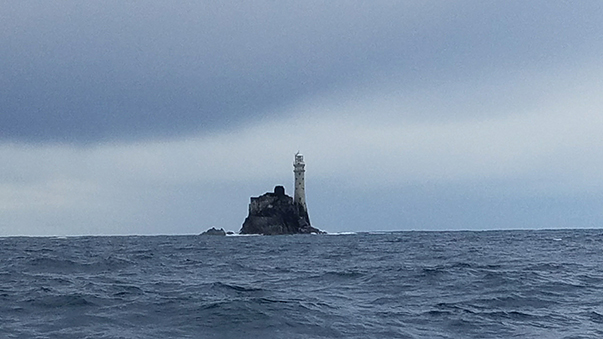 SAIL TROUBLE
SAIL TROUBLE
At 10am, we tore past the lighthouse on the islands off Land’s End, riding the large south west swell, and turned north into the Irish Sea. Then, the big mistake happened. In my rush to hoist the fractional spinnaker, I didn’t double check the halyard. I got it completely wrapped up in the roller furling solent (small jib). It was wrapped so badly that we couldn’t fix it from the deck. The leech was torn and we had ripped a hole at a batten pocket.
So, there we were, in last place, the solent half rolled up, leech flapping in the breeze and it was too windy to hoist the big spinnaker. I was shattered and extremely disappointed in myself for making a stupid mistake. Stef stayed calm and we talked through the problem. We decided to carry on and wait until the conditions calmed down enough to go up the rig to untangle the halyard and drop the solent. I went to sleep.
Two hours later, the wind and sea state had calmed down enough so I climbed the rig and freed the halyard. We dropped the solent to the deck and got it down below where we could repair it. The whole process took about a half an hour. We hoisted the big spinnaker and finally got Sirius back up to speed.
We laid the solent out in the forepeak and dried it off the best we could with paper towels. Using special sail tape, we re-attached the torn leech and fixed the hole at the batten pocket. During this process, the wind and sea state dropped to almost nothing. The wind had shifted to the east so we changed the kite for the Code 0 and beam reached through the afternoon due north toward Tuskar Rock in about seven knots of breeze. After two trips to the top of the mast and sail repair, we were back fully racing.
We did quite well for the next few hours and reeled in some miles on the guys ahead of us. Then the next problem got us. At sunset, the light easterly breeze built to 12 knots and by 10 pm it was 15. We were skirting around the traffic separation scheme (TSS) off the southeast coast of Ireland, which we were forbidden to go into, and sailing at 110 degrees true wind angle in 15 knots, fully ballasted, so the boat was cranked up. Not 30 seconds after commenting, “boy, we should probably get this Code 0 down”, Bang! The chafe cover on the tack line parted at the forward clutch. The tack eased up about 15 inches with only the core line intact.
Because of this, we couldn’t wind the tack down enough to get proper tension on the luff of the sail. When we tried to roll it up, the furling drum twisted the furling line on itself preventing us from rolling the sail up all the way. In the pitch black, my headlamp illuminating the bow spray, I fought the furling lines to get them to untwist. It was no use, and we reluctantly took the sail down, half furled up, and stuffed it down the forepeak hatch in a sopping bundle. This maneuver hadn’t cost us that much in terms of miles lost but it did mean that we couldn’t re-hoist the Code 0 unless the breeze was extremely light. This would haunt us in four day’s time. All in all, it was a tough day.
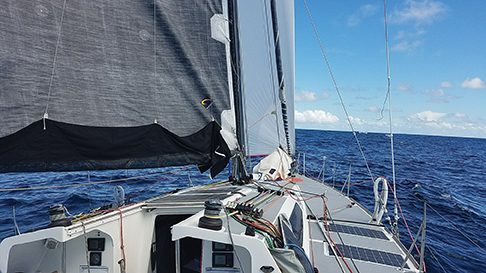 SLOGGING TO FASTNET
SLOGGING TO FASTNET
The next day turned out to be even harder. We rounded the lighthouse on Tuskar Rock at 4am, both of us pretty wiped out from our battles with the solent and the Code 0. We began our 130-mile upwind slog toward Fastnet Rock. The third morning was gorgeous, cold and clear. The wind dropped down to 10 knots and Stef and I were both able to get some good rest as we tacked back toward the dramatic Irish coastline, with emerald hills and cliffs spilling into the sea.
After midday, the breeze steadily built to 20 knots and by early afternoon, when we were off Cork, we were down to two reefs and the staysail. The pounding and slamming was incredible and almost unbearable. Class 40s are made for reaching and running and Sirius’ shallow forefoot violently slammed into the short, teal-colored waves. Every third or fourth slam was particularly violent, the whole boat and mast vibrating to the core. Resting and eating was almost impossible.
Under sunny skies, we slammed our way southwest for the rest for the day and into the night. Just as the final daylight gave up to night, I looked out across the streaked sea to glimpse a square topped mainsail of a Class 40 not a half mile to windward. Ha! We were still in the hunt. This turned out to be Fuji, skippered by two Finns, who we would chase for the next three days. A weak front passed over us during the night, bringing clouds and rain and causing havoc with the wind. The wind speed went up and then down to as low as eight knots and shifted through 30 degrees then back again as the clouds cleared.
By daylight we were still 15 miles from Fastnet and totally exhausted. We had to avoid another TSS directly to the south and east of the rock. So, we pushed deep, tacking along the story book islands close to shore. The islands off the south west coast of Ireland are magical. We passed under cliffs with the remains of a medieval castle standing watch above and a tiny hamlet nestled into a windswept cove. Slowly, we managed to get past the famous rock and by 10 am we could make the final tack for home. We were shattered but we could see Fuji about three miles in front. We had a target.
Our ordeal wasn’t over. The four knots of current swept us down to the TSS and we had to do one more tack out to the west to clear it. By the time we cleared the southwest corner of the TSS, the skies and our mood had improved significantly. Now, every mile we made was toward home.
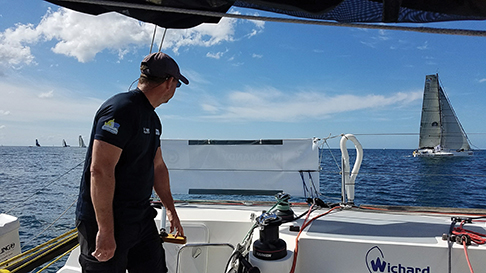 MATCH RACING WITH FUJI
MATCH RACING WITH FUJI
The sun came out and we were surrounded by huge pods of dolphins with sea birds diving in our wake. We even saw whales. After all the upwind work along the south coasts of England and Ireland, we finally had some proper downwind sailing. We fixed the tack line, cleaned up the boat, ate and did all the things that are very difficult while pounding upwind. The breeze had shifted west during the morning and we were able to cruise southeast under the big kite, right down the rhumb line to the western end of the Scilly islands.
As the day went on, the weather got nicer and nicer and our slog became a distant memory. By evening the big southwesterly swell dropped away and the wind had dropped to 10 knots. The sun set, lighting the clouds a glorious orange and dusk gave way to brilliant stars. We cruised through the night and by morning were even with the Scilly Islands, marking the extreme western end of Great Britain.
Around mid-morning we spied Fuji, who we had lost sight of the previous afternoon, coming in from the west. We jibed inside of them to head back to the east. The breeze was quite light at this point and Fuji was faster. After some debate, we decide to jibe back to the south to try to meet the forecasted build in wind pressure. Fuji jibed with us to cover.
We sailed south across the western reaches of the English Channel and jibed back to the east at the TSS at Ushant, at the western end of France, as the breeze built to 13 knots. Fuji jibed directly in front of us, about three miles ahead. The rest of the day was an amazing sleigh ride toward Guernsey . With a true wind direction of 290 at 15 knots of wind, our boat speed was in the low teens, we had sunny skies, flat seas and we were happy.
In the fresher breeze, we started to reel Fuji in but after sunset, the breeze went light again. At 1130, we jibed back to the south in search of an anticipated shift to the southwest and more wind. Over the next few hours, we crossed the main shipping channel. It felt like being a bunny on a highway. At 2am, we passed between two ships steaming to the east, one about a quarter mile in front and one a quarter mile behind. In the wee hours of the morning, squalls started to roll through with shifting, gusty winds and periodic rain.
By daylight, we were south of Guernsey and starting our hectic last day. Squalls passed over us causing the breeze to shift erratically. We had lost some miles to Fuji on our jog south during the night but we saw that they had gone through the channel between Guernsey and Sark and were only going three knots over the ground. Now was our opportunity to regain some miles.
We went to the east of Sark and the breeze built to 15, then 20 knots. After a full-blown wipe-out, we switched to the fractional kite and jibed back north. For the next few hours we ripped north at 13 knots. At noon, we passed through the Race du Alderney in a full squall under mainsail alone. We jibed again, this time to reach across the top of the Cherbourg Peninsula. We could see Fuji about four miles ahead.
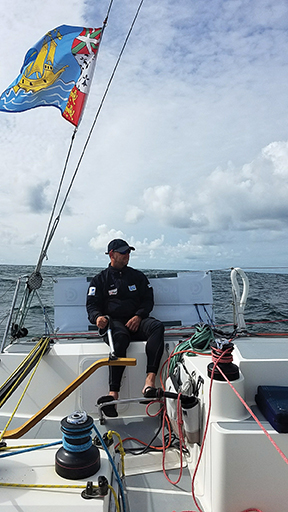 DRIFTING TO THE FINISH
DRIFTING TO THE FINISH
We had an amazing reach across the top of the peninsula. The wind stabilized at 15 knots from the southeast. We blasted along at 14 knots, the boat on rails, but as we approached the eastern end of the peninsula someone turned the wind dial down. Over the course of 15 minutes, the skies cleared and the wind dropped to five knots. We still had 50 miles to go, so we were thankful for the three knots of positive current.
We ghosted into the Baie de Seine praying the breeze would hold on and, as we got away from land, the wind filled back in giving us hope of finishing before sunset. Unfortunately for us, the breeze was perfect for the Code 0 that still lay crumpled in a heap in the forepeak from three days before. So, we tried every sail combination we could and finally ended up with the big spinnaker as the wind shifted aft and went lighter and lighter.
Every maneuver was more difficult as the exhaustion of five days of racing hard really settled in. Man, we wanted to get home. The last sunset of the race was gorgeous; turning the high clouds orange, then red, then pink. And that signaled the dying of the wind. By the time it was dark, the breeze had petered out to two knots and we drifted toward our goal, now only four miles away. We headed toward the beach looking for a land breeze, but to no avail. We just hung on, doing everything we could to keep the kite flying and keep Sirius pointed in the right direction.
Finally, around 1130 pm, we picked out the red and green lights marking the entrance of the channel to Ouistreham and then the flashing yellow light on top of the race committee boat. About 150 meters from the finish, a little breeze filtered out of the harbor and we doused the kite that had faithfully pulled us along these last miles. We got the solent out and did one last tack to the finish. We crossed the line at 1237 only 10 minutes behind Fuji! They had been becalmed within a mile of the finish for two hours.
Our adventure was over. It was a challenge from start to finish. We pulled alongside Fuji at the mouth of the lock and, instead of getting some much needed rest, we consumed a bottle of rum and traded sea stories until the lock opened at 4am.
It was amazing to be in France and to see this kind of sailing up close, let alone to take part. The racing level of the French sailors is absolutely incredible. Habelin finished at noon, 45 miles but over 12 hours ahead of us. The winners, Imerys, finished in 4 days, 11 hours, setting a course record.
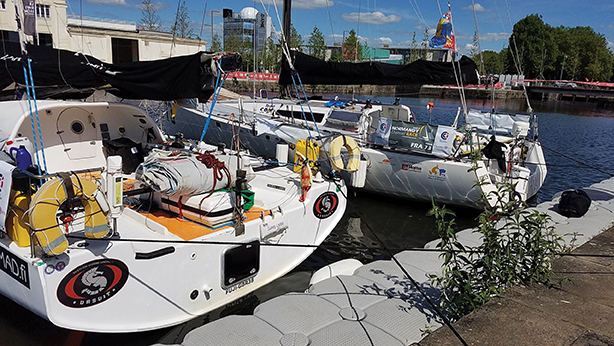 As amateurs playing in the big leagues, Stef and I had learned a lot. Sure, Sirius was slower than the newer boats and we did not expect to finish very high in the fleet. But, the boat looked after us and we sailed her as hard as we could. The match race with Fuji made the race that much more fun. And, by the time I put my head down to sleep, I was deeply happy that I had had a chance to compete in an event like the Normandy Channel Race.
As amateurs playing in the big leagues, Stef and I had learned a lot. Sure, Sirius was slower than the newer boats and we did not expect to finish very high in the fleet. But, the boat looked after us and we sailed her as hard as we could. The match race with Fuji made the race that much more fun. And, by the time I put my head down to sleep, I was deeply happy that I had had a chance to compete in an event like the Normandy Channel Race.
Simon Day is a design engineer at New England Boatworks in Portsmouth, RI. He races all over the world and as a boy completed a circumnavigation with his parents and brother Tim. He lives in Newport, RI with his wife Alex and baby daughter Charlotte.

















